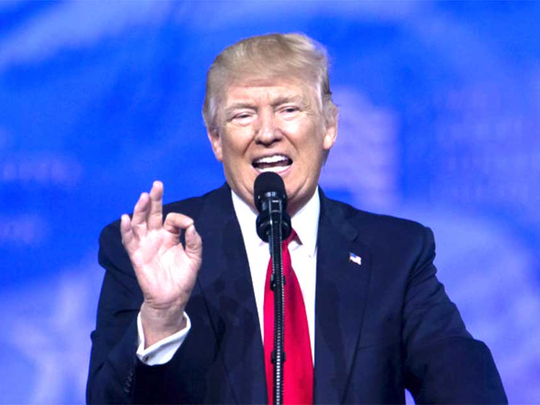
President Donald Trump on Tuesday gives his first major speech to Congress. The landmark address, after a frenzied five and a half weeks in office, will set out his pugnacious plan for 2017 and beyond with national security and foreign policy at the heart of this agenda, including possibility of rapprochement with Russia.
The speech, which will also focus on domestic policy areas like tax cuts, infrastructure and health care, will reaffirm “a new foreign policy direction”, potentially the biggest shake-up since 1945. This is challenging key elements of post-war orthodoxy pursued, in different ways, by Democratic and Republican presidents based, in part, around commitment to expanding the liberal democratic order.
Only on Friday, Trump re-affirmed his nationalist forward direction asserting he will soon make a budget request to Congress for “one of the greatest military build-ups in American history” to make the country’s defences “bigger and stronger than before so that nobody is going to mess with us”. He also confirmed Friday he is working on a new homeland security plan, including a fresh immigration clampdown so “foreign terrorists will not be able to strike America”, plus the hiring of up to 100,000 new border officials; and that work will start “ahead of schedule” on the Mexico “border wall” that could cost an estimated $21.5 billion (Dh79 billion); whilst developing a military plan to “obliterate” Daesh (the self-proclaimed Islamic State of Iraq and the Levant) abroad.
Since assuming office, Trump has also announced he may bring in a border tax to try to boost US manufacturing; reiterated his view that the country has “been devastated” by trade deals like the North American Free Trade Agreement, which his team is now reviewing, following his scrapping in January of US involvement in the Trans-Pacific Partnership; placed new sanctions on Iran and put the country “on notice”; sought to introduce a temporary immigration ban for seven Muslim-majority countries; warned of need for greater burden sharing with allies including Europe and Japan; hinted at withdraw from the Paris climate change deal; and indicated there will be more combative relations with China.
In coming weeks, following Trump’s meetings with several world leaders — including UK, Israeli, Japanese and Canadian Prime Ministers Theresa May, Benjamin Netanyahu, Shinzo Abe and Justin Trudeau respectively — the president will be turning more of his attention to other great powers, including China and Russia. Already, the president has spoken on the phone with Presidents Vladimir Putin and Xi Jinping and face-to-face meetings will happen later this year.
On Friday, Trump called Beijing the “grand champions of currency manipulation” and it already clear that country could become a bête noire of the administration, with potentially significant tensions on the horizon. Underlying the president’s hawkish sentiment is a conviction that China represents the primary threat to US interests globally and this is one area of policy where he appears aligned with his cabinet.
For instance, both Defence Secretary James Mattis and Secretary of State Rex Tillerson have slammed Beijing’s behaviour. Mattis accused China earlier this month of “shredding the trust” of its neighbours, and his remarks build on those by Tillerson who said that Beijing should “not be allowed access” to its new, artificial islands in the South China Sea.
Yet, Trump has also acknowledged that China can also play a potentially very constructive role in key areas such as North Korea’s continuing provocations. In this context, the business dealmaker in Trump has surfaced with his comments that “everything is under negotiation” with Beijing, and it appears that he may ultimately be looking for a grand bargain extending beyond the security arena to economics too. Here, one specific measure Trump wants to see is China floating the yuan: he asserts that the country is manipulating its currency by keeping its exchange rate artificially low in order to secure export advantage.
With Congress already looking into allegations of the Trump team’s ties with Moscow, the president’s stance toward Russia has potential to be the single most controversial area of his foreign policy. Already, his national security adviser Stephen Flynn has been forced to resign after misleading Vice-President Mike Pence over conversations he had with Russian Ambassador Sergey Kislyev over US sanctions.
It is clear that, at heart, Trump appears to believe Russia is not a serious threat to the United States, and that there is scope for rapprochement, even hinting in January that he could drop economic sanctions if the country “is helpful”. Specifically, he perceives there are common interests over issues such as preventing Iran secure nuclear weapons, combating terrorism, and potentially even helping contain China in a new global balance of power.
However, there are strongly contrasting views within his cabinet, including Pence who last week called for Russia to be “accountable” for its actions. Moreover, Mattis last month said that Moscow “is raising grave concerns on several fronts”, while Tillerson has also been forceful in his criticism of Russia.
How this internal administration battle pans out will be an intriguing test of the balance of power within it. And one key area which will be most keenly watched, internationally, will be how any warming ties with Moscow may impact Nato.
Already, uncertainty over Trump’s Nato stance is spurring Europeans to seek to reverse around a decade of defence spending cuts, totalling around 10 per cent in real terms. To this end, a new European Defence Action Plan was discussed at December’s EU summit that could see greater continental military cooperation too.
Taken overall, Tuesday’s speech will reassert the ‘America First’ vision of Trump’s presidency. In coming months, he will increasingly flesh out his stance toward Russia and China which will help reveal not just the balance of power within the administration, but also the likely scope of the potential transformation of US foreign and national security policy in coming years.
Andrew Hammond is an Associate at LSE IDEAS (the Centre for International Affairs, Diplomacy and Strategy) at the London School of Economics












